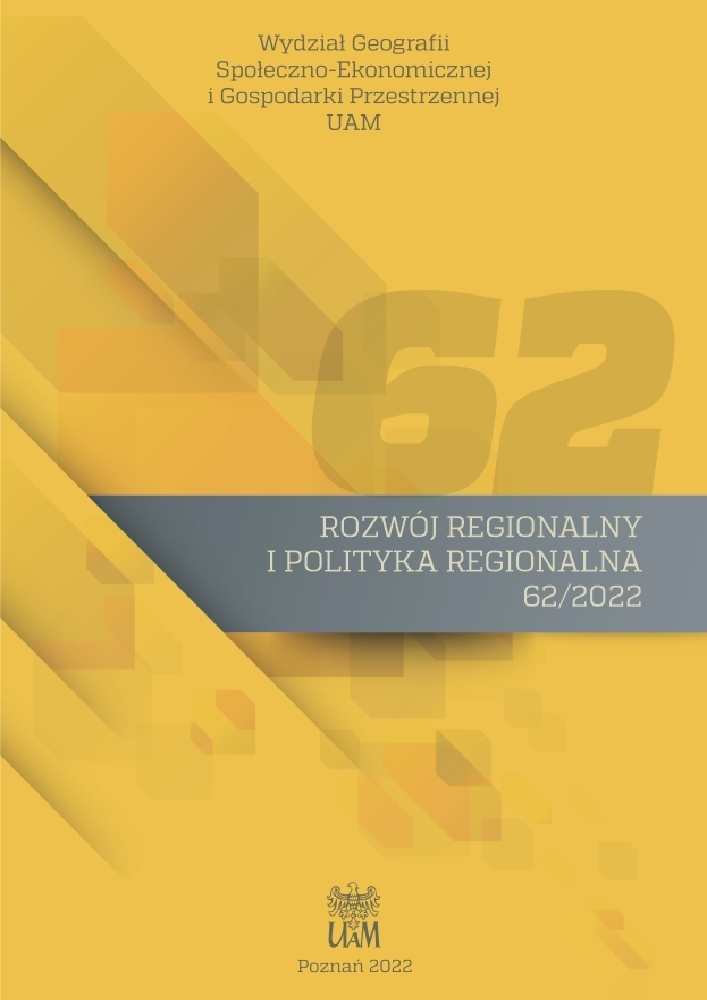Abstract
This article is a part of an interdisciplinary research project entitled „Pandemic traces – Rural communities and institutions”, which was conducted by the Institute of Rural and Agricultural Development, Polish Academy of Sciences. The research touched many aspects of local and social experiences and consequences of the coronavirus epidemic. The outcome is a result of a study in one of the Greater Poland communes, which, in addition to direct participant observation and document analysis, mostly used quantitative studies performed in April 2021 on a representative group of adult residents of the commune.The local dimension of the epidemic was measured within 3 research areas. The first one dealt with personal experience, especially the impact of the pandemic on private and professional life. The sec-ond one focused on the evaluation of the institutions and authorities during the pandemic. The last area analyzed how the local community judged the restrictions the state government imposed.During the quantitative analysis a special attention was paid to capture the differences between the respondents as regards their social and professional status, as well as demographics and the residency (a town or a countryside).The research showed some regularities. First of all, the percentage of respondents who were afraid of COVID-19 infection and for whom the epidemic had an impact on everyday life (approx. 53%) was similar. These groups share a common socio-demographic profile. They were dominated by women, seniors, people with higher education and representatives of the liberal professions. Another char-acteristic indication of the respondents was the critical attitude towards the local health service, es-pecially family doctors. Such responses were indicated in particular by rural residents, who probably have had worse access to basic health care.
Development, Polish Academy of Sciences. The research touched many aspects of local and social experiences and consequences of the coronavirus epidemic. The outcome is a result of a study in one of the Greater Poland communes, which, in addition to direct participant observation and document analysis, mostly used quantitative studies performed in April 2021 on a representative group of adult residents of the commune.
The local dimension of the epidemic was measured within 3 research areas. The first one dealt with personal experience, especially the impact of the pandemic on private and professional life. The second one focused on the evaluation of the institutions and authorities during the pandemic. The last area analyzed how the local community judged the restrictions the state government imposed.
During the quantitative analysis a special attention was paid to capture the differences between the respondents as regards their social and professional status, as well as demographics and the residency (a town or a countryside).
The research showed some regularities. First of all, the percentage of respondents who were afraid of COVID-19 infection and for whom the epidemic had an impact on everyday life (approx. 53%) was similar. These groups share a common socio-demographic profile. They were dominated by women, seniors, people with higher education and representatives of the liberal professions. Another characteristic indication of the respondents was the critical attitude towards the local health service, especially family doctors. Such responses were indicated in particular by rural residents, who probably have had worse access to basic health care.
Funding
Interdyscyplinarny projekt badawczy „Wiejskie okruchy pandemii – społeczności i ich instytucje” realizowany w Instytucie Rozwoju Wsi i Rolnictwa Polskiej Akademii Nauk
References
Burawoy M. 1998. The Extended Case Method. Sociological Theory, 16(1): 4-32. https://doi.org/10.1111/0735-2751.00040 DOI: https://doi.org/10.1111/0735-2751.00040
CBOS 2021 (48). Obawy przed zarażeniem się koronawirusem i ocena działań rządu w kwietniu. Komunikat z badań (opracowała: B. Roguska). Warszawa.
Gwizdek J., Wiaderek G. 2021. Tarcze antykryzysowe – dokończenie budowy państwa PiS-u? Ustawodawstwo okresu pandemii a wymiar sprawiedliwości i prawa obywatelskie. Fundacja Batorego, Warszawa.
Halamska M. 2020. Wiejskie okruchy pandemii – społeczności i ich społeczności. Wprowadzenie do numeru tematycznego. Wieś i Rolnictwo, 3: 7-11.
Halamska M., Burdyka K., Kalinowski S., Kubicki P., Michalska S. Ptak A., Sadłoń W., Zwęglińska-Gałecka D. 2021. Wiejskie okruchy pandemii – rok drugi przed czwartą falą. Wieś i Rolnictwo, 3: 11-48. https://doi.org/10.53098/wir032021/01 DOI: https://doi.org/10.53098/wir032021/01
Halamska M., Kurczewski J., Ptak A. 2020. Władza lokalna w stanie niezwyczajnym. Wieś i Rolnictwo, 3: 91-118. https://doi.org/10.53098/wir032020/05 DOI: https://doi.org/10.53098/wir032020/05
Makowski G., Waszak M. 2020. Tarcze antykryzysowe – dokończenie budowy państwa PiS-u? Ustawodawstwo okresu pandemii a korupcja. Fundacja Batorego, Warszawa.
RPO 2021. Raport na temat pandemii. Doświadczenia i wnioski. Biuro Rzecznika Praw Obywatelskich, Warszawa.
Śleszyński P. 2021. Struktura przestrzenna i dynamika w czasie zakażeń koronawirusem SARS-CoV-2 w Polsce (marzec 2020-czerwiec 2021). Komitet Nauk Demograficznych PAN, Warszawa. Maszynopis.
Śleszyński P. 2021a. Analiza i wariantowa prognoza procesów demograficznych w gminie Orlin. Warszawa.
Zwęglińska-Gałecka D. 2020. Koronakryzys. Lokalne zróżnicowanie globalnej pandemii. Wieś i Rolnictwo, 3: 67-90. https://doi.org/10.53098/wir032020/04 DOI: https://doi.org/10.53098/wir032020/04
License
Copyright (c) 2022 Maria Halamska, Arkadiusz Ptak

This work is licensed under a Creative Commons Attribution 4.0 International License.

